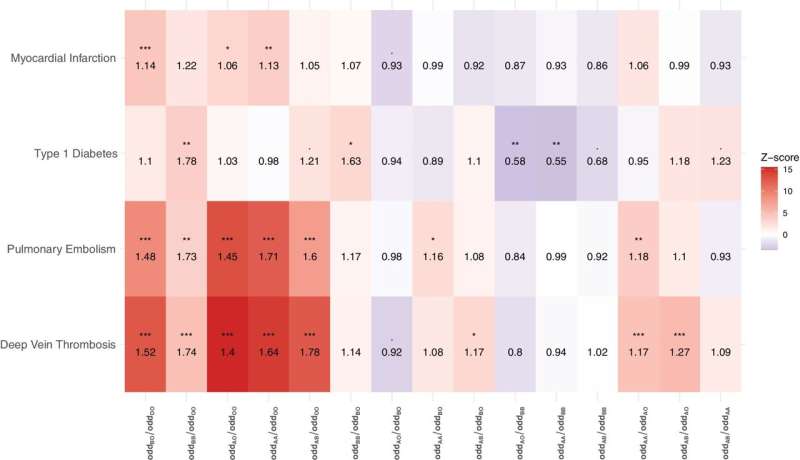Results from the regression analysis for all diseases where ABO contributed significantly to the association. Based on the full UKB cohort. All diseases are stated on the y axis, the ABO genotype comparison is stated on the x axis with their respective ratio. For visualization purposes, the diseases have been clustered with hierarchical clustering by their respective odds ratios. Odds ratios for each disease and ABO genotype comparison are shown within each square. Squares are colored by Z-score, where blue depicts a negative Z-score and red a positive Z-score. Significance thresholds correspond to: p < 0.05 = · (a dot), p < 0.01 = *, p < 0.001 = **, p < 0.0001 = ***. Credit: DOI: 10.1002/ajh.26307
Determining an individual's blood group based on genetic tests instead of merely traditional blood tests can provide a better picture of the risk of cardiovascular diseases. If a patient has two genetic variants of A, B or AB, the risk is twice as high compared with if one is O. This is the finding of a new study from the Uppsala University using data from UK Biobank.
"There is a large difference for the risk for blood clots, depending on if someone has one or two genetic variants of the blood groups A, AB or B. Simply put, there is twice the risk of suffering from blood clots if you have two variants of A or B rather than just one," says Julia Höglund, a doctoral student at the Department of Immunology, Genetics and Pathology at Uppsala University and the study's first author.
An individual can have one of four blood groups: A, B, AB or O. An individual's blood group is critical, for example, when receiving blood transfusions. Recently, it has been shown that blood group also plays a role in how a person is infected by viruses and bacteria and even for the occurrence of cardiovascular diseases and cancer.
The study now being published shows that the genetic variants an individual receives from each of their parents also influence the risk of disease. The study is based on data from 500,000 subjects included in the population study UK Biobank. The researchers have conducted a more in-depth analysis of the genetics behind blood groups.
Like previous research, this study shows that individuals with blood group O are at a lower risk of cardiovascular disease, such as blood clots, than those that have other blood groups. But by genetically analyzing the blood groups rather than using traditional blood analysis, which is done using antibody tests, the researchers could determine which genetic variant a person had from each parent. This can be significant in identifying diseases since an individual with blood group A can have either two genetic variants for A or one for A and one for O.
"This is not detected in a regular blood test since both A and B mask the O gene. A person's genetic variants play a big role in the risk for cardiovascular diseases. If this was the standard method used with patients, it would significantly improve the ability to find high-risk patients," says Höglund.
Another finding from the study is that the researchers could see that the levels for multiple proteins differed between individuals with different blood groups. The most clear example of this was proteins that help the blood to coagulate. The same blood groups that increase the risk of blood clots also had increased levels of proteins that are important for the coagulation of blood.
"Our findings show that by making it standard to determine the patient's blood group and the blood group's genetics, we would be able to discover and begin treating diseases at an early stage, which can prevent or delay serious complications."
More information: Julia Höglund et al, Characterization of the human ABO genotypes and their association to common inflammatory and cardiovascular diseases in the UK Biobank, American Journal of Hematology (2021). DOI: 10.1002/ajh.26307
Journal information: American Journal of Hematology
Provided by Uppsala University























